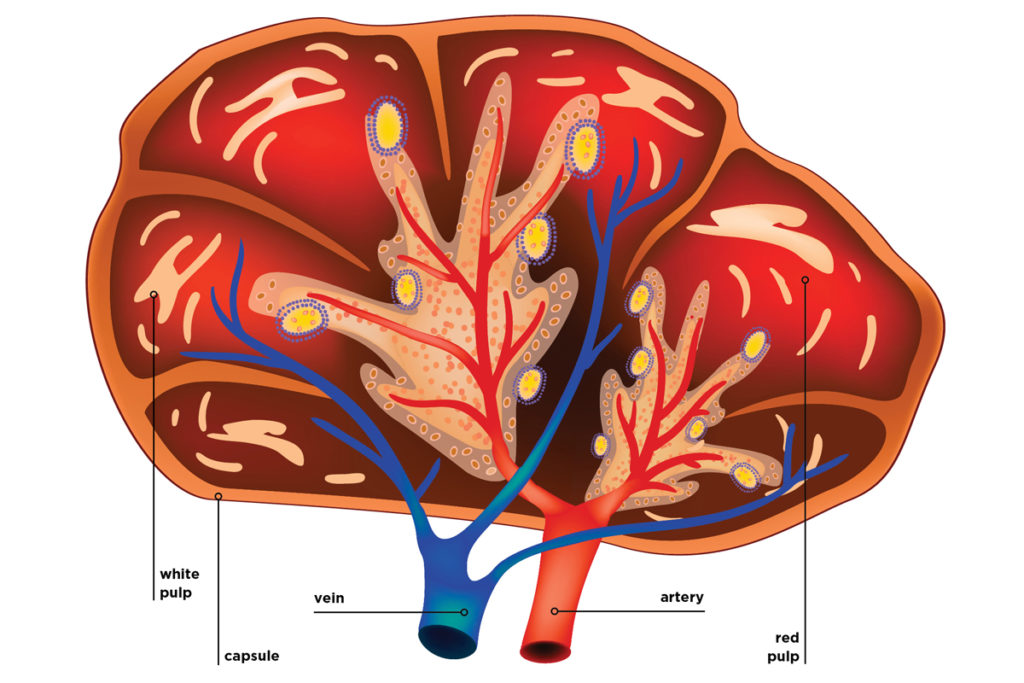Screening the Spleen
This small, protective organ filters your blood and boosts immunity.

Though known for being a nonessential organ, the spleen plays a significant role in immunity and blood health. Located in the upper-left part of the abdomen beneath the rib cage, it is the largest organ in the lymphatic system. As the blood’s filtration mechanism, it detects the presence of microorganisms and helps maintain healthy blood cells.
The spleen is made up of two types of tissue:
- white pulp, which contains immune cells and fights infection; and
- red pulp, which removes old or damaged red blood cells (Szalay 2018).
As it filters out old blood cells, the spleen saves useful components, including iron, to use in new cells. It also stores blood—up to a cup—for later release back into the bloodstream when the body experiences trauma and needs a quick supply (Szalay 2018).
The spleen’s powerful protection comes in handy for immunity, too. When it detects bacteria, the organ—together with lymph nodes—generates defender white blood cells called lymphocytes, which produce antibodies to fight off infection (UPMC 2020).
Sift through more valuable information about the spleen:
- The spleen is wrapped in a fibroelastic capsule that allows it to significantly expand its size
(Vaskovi 2020). - A healthy adult spleen weighs around 7 ounces but can swell—in a process called splenomegaly—in response to infections, liver disease and some blood cancers (Queensland Health 2018).
- Splenectomy is the surgical removal of the spleen due to extensive splenomegaly, rupture of the spleen, severe infection or blood disorders (Vaskovi 2020).
- Though the spleen’s functions can be completed by the liver and lymph nodes, removal of the spleen can threaten immunity and increase the risk of developing infections (Szalay 2018).
- Nutrition that supports the liver also supports the spleen. Beneficial foods include fruits, vegetables, whole grains and choices that improve blood sugar regulation. The spleen also benefits from anti-inflammatory foods, such as tomatoes, olive oil, nuts and fatty fish (Benninghoven 2019).
References
Benninghoven, D. 2019. Foods for a healthy spleen. LIVESTRONG.com. Accessed Aug. 18, 2020: livestrong.com/article/336844-foods-for-a-healthy-spleen.
Queensland Health. 2018. 4 cool facts about your spleen. Accessed Aug. 18, 2020: health.qld.gov.au/news-events/news/facts-about-your-spleen-splenectomy-immune-system-what-is.
Szalay, J. 2018. Spleen: function, location & problems. Live Science. Accessed Aug. 18, 2020: livescience.com/44725-spleen.html.
UPMC (University of Pittsburgh Medical Center). 2020. What does the spleen do? Accessed Aug. 18, 2020: chp.edu/our-services/transplant/liver/education/organs/spleen-information.
Vasković, J. 2020. Spleen. Kenhub. Accessed Aug. 18, 2020: kenhub.com/en/library/anatomy/the-spleen.
Sarah Kolvas
Sarah Kolvas is the content manager for IDEA.



